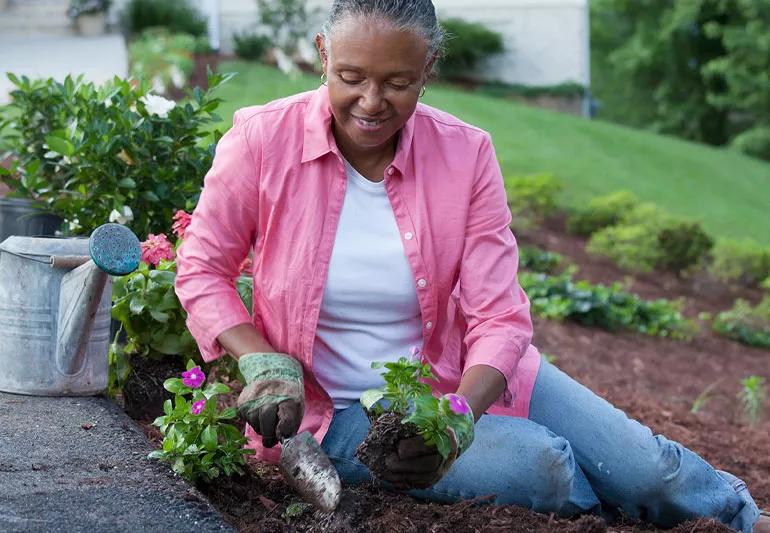Transform Your Room with Innovative Gardening Tips for every single Season
Wiki Article
Specialist Gardening Tips for Producing a Lasting and Eco-Friendly Yard
Embarking on the journey to produce a lasting and environmentally friendly yard entails a collection of deliberate selections and techniques that not just improve the charm of your space yet additionally add positively to the environment. By selecting indigenous plants that are fit to your area, you can minimize dependence on chemical plant foods and chemicals while supplying necessary assistance to regional wildlife. Additionally, incorporating water conservation strategies and natural gardening methods plays an essential role in maintaining a healthy community. To uncover more practical approaches and experienced insights, let us check out the essential elements that define an eco mindful yard.Choose Native Plants
Choosing native plants for your garden is an essential step toward accomplishing sustainability. Furthermore, indigenous plants normally call for much less water as soon as developed, adding to extra efficient water usage.Past their practical benefits, native plants play an important function in supporting regional biodiversity. They offer important habitat and food sources for native wildlife, consisting of pollinators such as butterflies, bees, and birds. This fosters a balanced ecosystem, which is vital for the health of your garden and the surrounding setting.

Implement Water Conservation
Carrying out water preservation strategies is important for maintaining a lasting yard. Reliable water usage not just lowers the ecological influence yet also guarantees that plants get appropriate hydration without wastefulness. One reliable method is to utilize drip irrigation systems, which provide water directly to the plant roots, minimizing dissipation and drainage. This targeted strategy can considerably reduce water usage compared to conventional sprinklers.On top of that, mulching is a useful method for saving water. By applying a layer of organic mulch, such as timber chips or straw, around the base of plants, garden enthusiasts can decrease dirt dissipation and keep regular wetness levels. Mulch also aids manage dirt temperature level and reduces weed growth, further contributing to plant health.
Rainwater harvesting is another lasting approach. Installing rainfall barrels or various other collection systems enables gardeners to save and catch rainwater, which can later be used during dry durations. This not just preserves metropolitan water yet additionally gives an all-natural, chemical-free source for irrigation.
Last but not least, picking drought-tolerant plant varieties can significantly reduce water needs. These plants are adjusted to thrive in low-water problems, making them excellent for environmentally friendly gardens. gardening tips. Applying these water preservation techniques will foster a durable, sustainable yard
Use Organic Gardening Approaches

Pest administration in an organic garden counts on incorporated pest administration (IPM) strategies. These include encouraging valuable insects, utilizing all-natural predators like ladybugs and lacewings, and executing crop rotation to disrupt pest life process. Buddy growing, where specific plants are grown with each other to ward off parasites or attract helpful pests, is an additional efficient method.
Weed control is managed through mulching and hand-operated elimination, instead than depending on herbicides. Mulch not just subdues weeds however also preserves moisture and boosts soil health as it damages down. Organic composts, such as straw, wood chips, and leaves, are particularly beneficial.
Develop Wildlife Habitats
Developing wild animals habitats within your yard not only enhances biodiversity yet likewise supports the ecosystem's equilibrium. By developing spaces that bring in and sustain local animals, you can produce a thriving micro-ecosystem that profits both plants and pets. Start by including native plants, as these are well-suited to your neighborhood climate and give necessary food and shelter for wild animals. Native vegetation supports an array of bugs, birds, and small creatures, adding to the eco-friendly network.Take into consideration including a water function, such as a pond or birdbath, to supply a constant water source. Water aspects attract a selection of types, from amphibians to pollinators, enhancing the yard's vitality. Furthermore, installing birdhouses, bat boxes, and insect hotels offers safe nesting websites and encourages biodiversity.
Leave some areas of your yard undisturbed, permitting ground cover and fallen branches to accumulate. These all-natural see this page debris stacks develop habitats for bugs and little animals, fostering a well balanced ecological community. Avoid making use of chemical pesticides and herbicides, as they can harm read review valuable wildlife and interrupt food web. By prioritizing these lasting techniques, your garden can become a shelter for neighborhood wild animals, advertising environmental wellness and sustainability.
Practice Composting and Mulching
A vital element of sustainable gardening, composting and mulching, significantly improves soil health and wellness and reduces waste. Composting includes recycling organic products such as kitchen scraps, yard trimmings, and leaves. These materials decompose to develop nutrient-rich compost, which works as an all-natural plant food. Unlike synthetic plant foods, compost enhances the dirt with valuable microorganisms and necessary nutrients, fostering a healthier yard community.Mulching, on the other hand, involves covering the soil surface with inorganic or natural products, such as straw, timber chips, or shredded fallen leaves. This technique uses numerous advantages: it conserves dirt wetness, suppresses weed development, and moderates soil temperature. Mulch also progressively breaks down, including raw material to the dirt and additional enhancing its fertility.
To practice effective composting, guarantee your compost heap has a balance of environment-friendly products (rich in nitrogen) and brownish materials (rich in carbon), keeping adequate oygenation and moisture. gardening tips. Regularly transforming the heap accelerates disintegration. For mulching, use a 2-3 inch layer around plants, guaranteeing it does not directly speak to stems or trunks to stop rot
Final Thought

Choosing native plants for your yard is an essential step towards achieving sustainability.Moreover, integrating native plants can enhance the try this out visual charm of your yard. These plants are adjusted to prosper in low-water conditions, making them excellent for green yards. Executing these water conservation methods will certainly foster a durable, sustainable yard.
In final thought, establishing a environment-friendly and sustainable yard involves the calculated selection of native plants, the fostering of water conservation strategies, and the implementation of natural horticulture methods.
Report this wiki page